There are various species of rays found around the coast of the UK. Sometimes a tricky catch, but often plentiful when you find where they are feeding. Hook a big ray and these powerful fish will certainly put a bend in your rod! Here are some tips on where to target and how to catch rays from the kayak …
What is a ray?
Rays are peculiar looking fish that have a flattened body. They are related to sharks and spend much of their time living on the seabed. Their flattened body is well suited to living in the 2D world at the bottom of the sea, and this is where they hunt their prey of small fish, mollusks and crustaceans. Rays are a popular target for the recreational fisherman and they are well known for putting a good bend in the rod!
When is a ray not a ray? When it’s a skate!
Numerous species of ray inhabit UK waters, but technically speaking the fish that anglers call rays are in most cases actually species of skate. The reasoning behind this is biological. True rays are viviparous or live-bearers. This means that they give birth to fully functioning live young just like us humans! Now, the many of the species we call ray in the UK are not viviparous. Take a walk along the strandline of your local beach after an onshore storm. You may find some mermaid’s purses. These are the egg cases (usually empty if washed up) which would have once contained the developing young of the fish we call rays! The technical term for this is ‘oviparous’ and it is skate not rays which show this form of reproduction where the young develop independently of the mother. Seeing as the use of the term ray is so well embedded in the angling community I will be referring to the skate species in this article as ray! Confused yet?
There are in fact a few species of true ray found in UK waters but they are particularly rare and require a specialist approach for targeting on rod on line. They are also fairly dangerous as one group; the electric rays can electrocute you with surprising voltage, and the stingrays … well they have stingers in their tails!
Ray species
There are five species of rays that are a realistic target for the kayak angler:
- Thornback ray – Raja clavata
- Small-eyed ray – Raja microcellatus
- Blonde ray – Raja brachyura
- Spotted ray – Raja montagui
- Undulate ray – Raja undulata
These species are relatively straightforward to target from the kayak, however, location plays a big part as to what species you may expect to catch from your local marks.
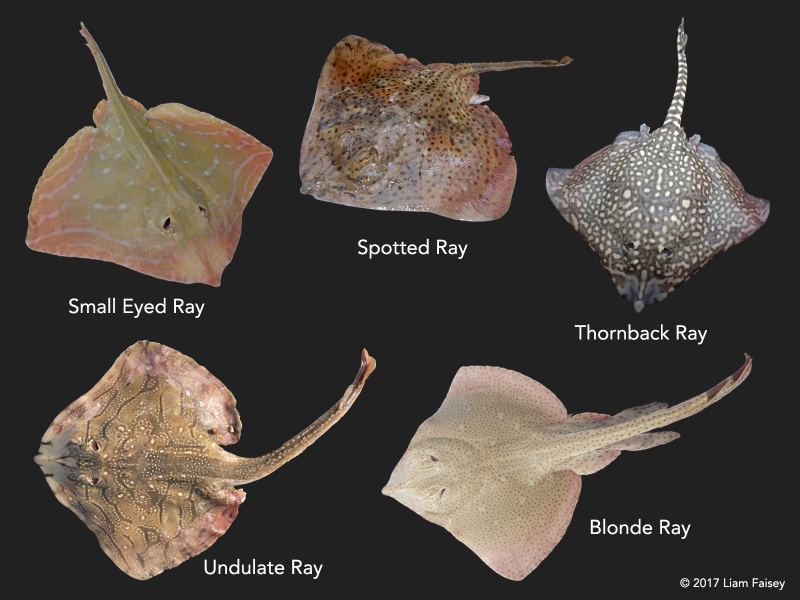
There are a number of ray species that can be caught whilst kayak fishing
The Thornback Ray is a fairly widespread species but regional variations will dictate which habitat they will be found over. In some regions, thornbacks favour estuaries and sheltered bays with muddy-sandy ground, in other regions they can be found on open coastline off beaches. Thornback rays can grow to over 20 lb but such fish are rare and most fish are between 3 – 10 lb in weight. A 10 lb+ fish is a good specimen.
The Small-Eyed Ray is a species mainly found on southern and western shores of the UK and tends to favour clean sandy ground, and sometimes, muddier ground such as those living within the Bristol Channel. Small-eyed rays can grow to over 15 lb but are commonly caught between 3 – 10 lbs, with a 10 lb+ fish a good specimen.
The Blonde Ray is a species that again is mainly found on southern and western shores, often favouring deeper waters over clean ground. Blonde rays can grow in excess of 30 lb with fish often caught between 5 – 20 lb. A 20 lb+ fish is a good specimen.
The Spotted Ray is fairly widespread and can be found in a range of habitats from estuarine waters to open coastlines. Spotted Ray are a smaller species that can grow up to 8lbs but are more commonly caught between 2 – 5 lb. A 5 lb+ fish is a good specimen.
The Undulate Ray has a fairly well-defined range on the South coast, ranging mainly from Dorset to Kent, and they are particularly abundant around the waters of the Solent. Very few fish get recorded outside of this range. Undulate ray can grow to over 20 lbs but are more commonly caught between 5 and 12 lbs. A 12 lb+ is a good specimen.
Where to find rays?
All rays favour clean ground and any efforts targeting them should be here. This may be the shallow waters just off a sand or shingle beach, deeper clean ground further offshore or the muddier waters of a tidal estuary. In general, rays tend to like a bit of tidal flow too, so look for areas of clean ground exposed to the main tidal flow in the area. Clean ground just off of headlands, the middle of bays, offshore sandbanks, the entrances to small estuaries and known channels/banks within larger estuaries tend to be good places to fish. You usually don’t need to paddle far to find a good spot either with rays often coming very close to shore, but I tend to look for water of at least 10 m / 30 ft before I start fishing.
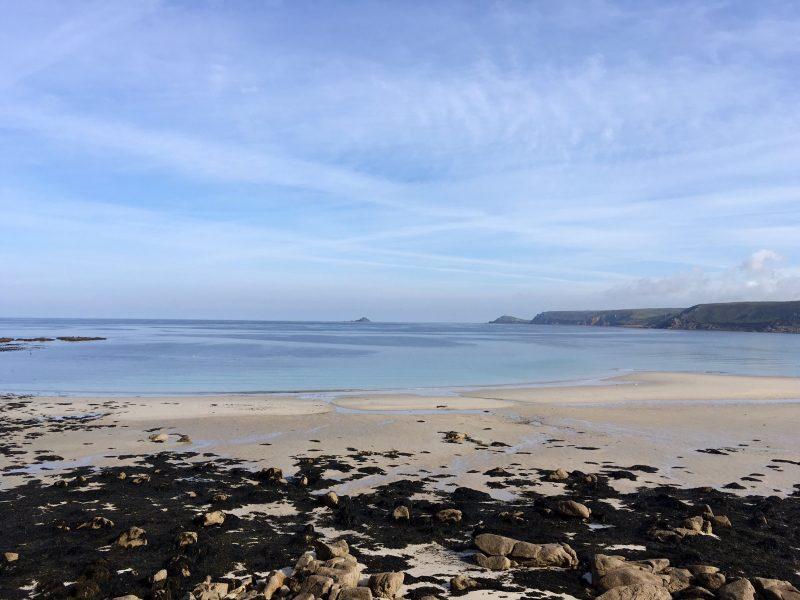
Sandy Bays are good places to target Rays
How to catch ray from a kayak
When targeting ray it is almost essential to fish at anchor. Rays tend to stick to a particular area of ground where they will either rest on the seabed opportunistically grabbing food items that pass them by, or actively swim around hunting food that is living on or in the seabed or food that is swimming close to it. Fishing at anchor allows to you present a bait which is hard on the bottom allowing the ray to come and find it. Rays have a very good sense of smell and will travel to find potential food items if they pick up a scent. Rays will often ‘play’ with a bait before actually eating it so fishing static allows for them to do this without the bait moving away from them.
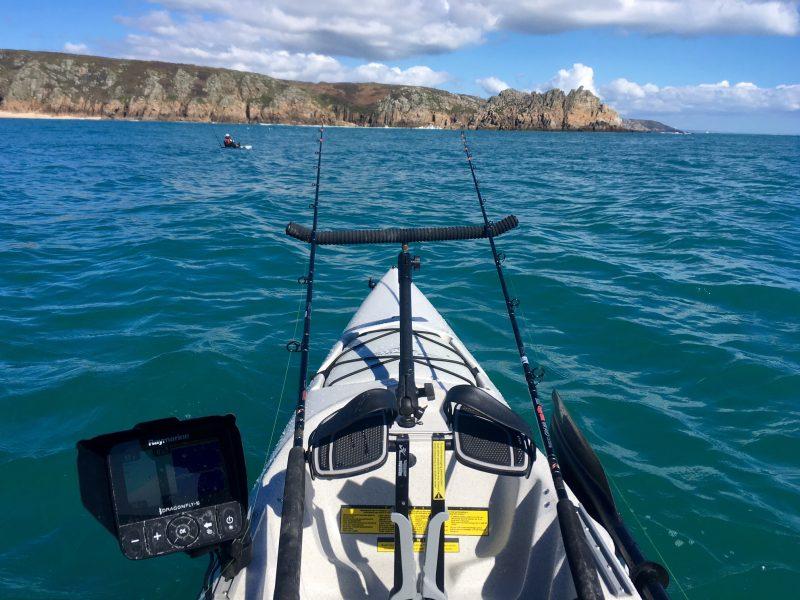
Fishing at anchor gives you the best chance of catching a ray
The odd ray will be caught to slow (less than 0.5 knots) drift fished baits and in some cases, a slow drift will catch more ray than fishing at anchor as you cover more ground. If it is a particularly calm day with little wind or tide to move the kayak it often pays to slowly drift over an area to find the rays before anchoring. As most good ray marks are usually in areas of tidal flow it is usually best to be anchored from the off.
Baits for catching rays
Fish baits work well for all species of ray discussed here, with a simple medium sized sand eel difficult to beat in most cases. For larger specimens, a large sand eel/launce, half a fillet of mackerel or a whole fillet of mackerel can be deadly. 15 lb+ fish are capable of devouring whole mackerel and mackerel flappers so don’t be afraid to go big. One of my favourite baits for big ray is a live joey mackerel. Other fish baits also work such as bluey, garfish, herring and more, along with squid. Thornbacks will also take peeler crabs and occasionally worm baits too.
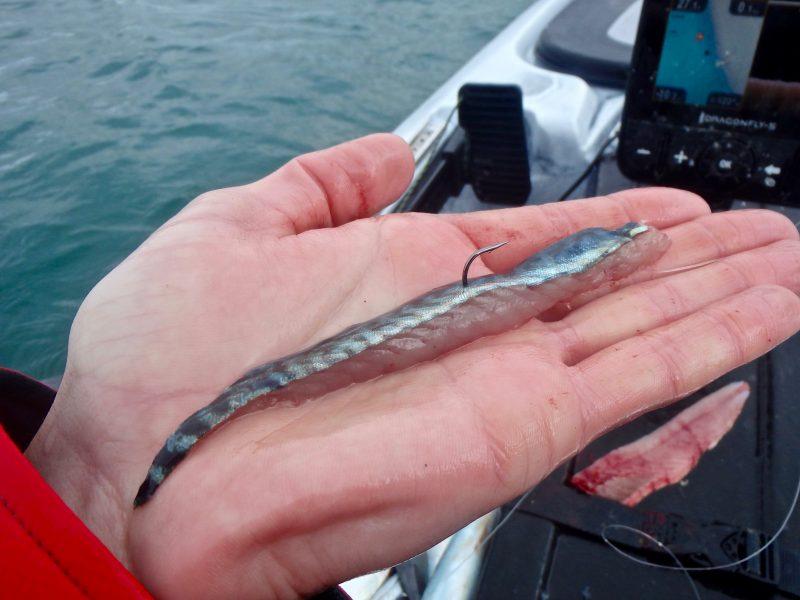
Not many rays can resist a fresh sliver of mackerel
Fishing tackle for catching rays
In most cases a 6-12 lb class boat rod is ample for tackling a ray from the kayak. In some cases where there are stronger tidal flows or deeper water requiring heavier leads to be used, a 12-20 lb rod is preferable. On the flip side, in areas of slower tidal flow and shallower waters, lighter gear can be used such as a spinning/lure rod for even more fun! Pair up your rod with a multiplier or fixed spool loaded with 30 lb braid. Braid is practically essential for all kayak fishing applications, giving direct contact with the bait and increased bite detection.
The rig is a very simple running ledger rig. This allows for a bait to be presented right on the bottom where the rays are grubbing around. The running ledger is very versatile rig and by using a zip slider, or link swivel, you can easily change the amount of lead used during a fishing session should the tidal flow increase or decrease. Ray will often grab a bait and run before fully engulfing it, so a sliding rig allows the fish to move off with the bait without dragging the lead with it, which may cause the fish to drop the bait.
Use a 4-8 ft trace of 40 or 50 lb monofilament line to combat the tough and powerful lips of a ray from wearing through your line. A longer trace gives more movement to the bait in the tide, and also allows the bait to sit further from your main line, reducing the number of false bites you get from a ray playing with and settling on the hook bait.
Terminate the trace in a 2/0 – 6/0 Aberdeen style hook. Use thicker patterns when targeting bigger fish with bigger baits. I favour Sakuma Stingers in 2/0 for sandeel baits and Stingers in 4/0 for larger mackerel strips. Sakuma Manta Extras in 5/0 and 6/0 have a wider gape than the Stingers and work well for whole fillets and larger fish baits. Short shank patterns such as Sakuma Chinus work well if using small live-baits such as joey mackerel or sand eels.
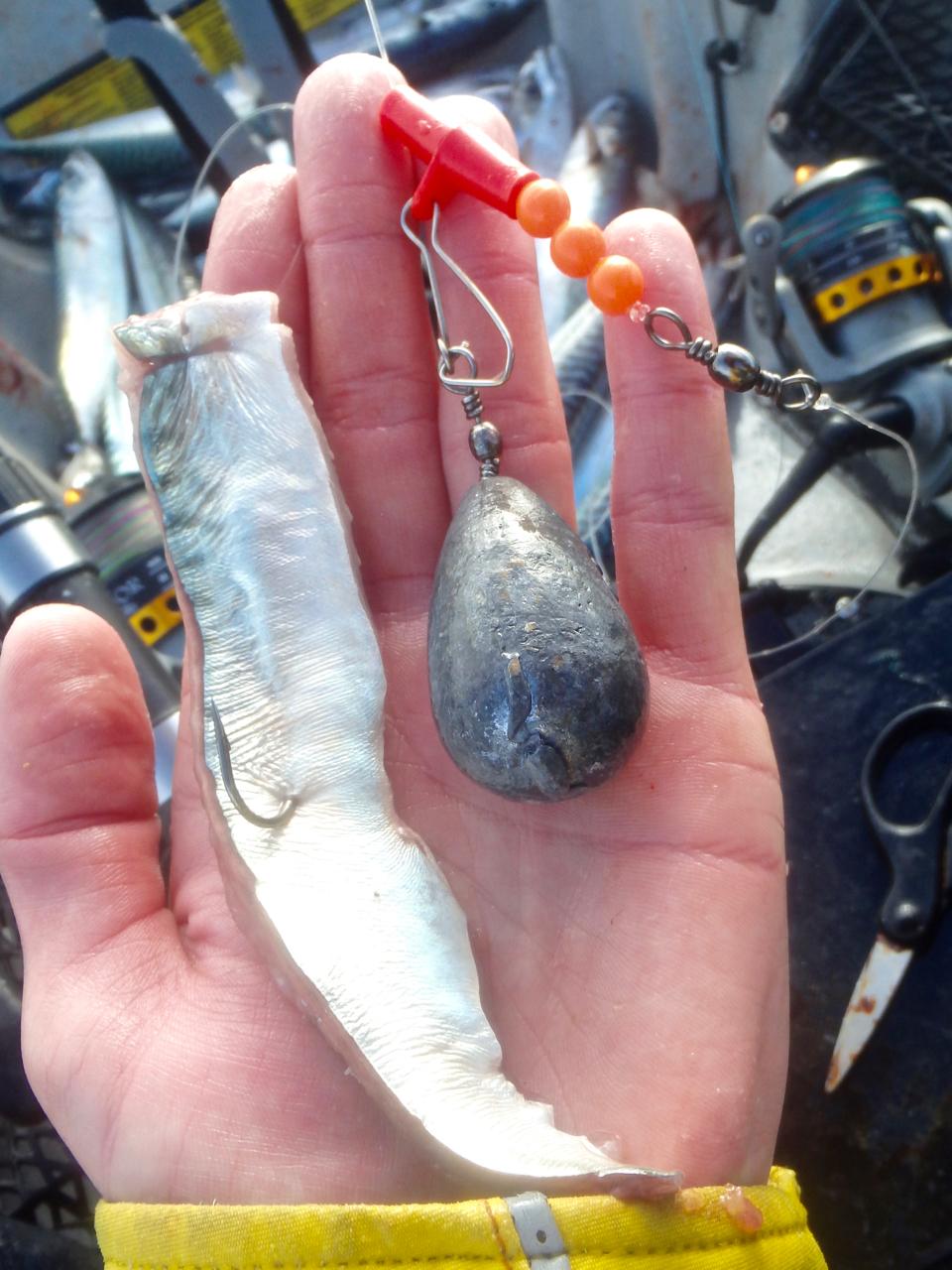
A typical running ledger rig that i use for Ray fishing
Down-tide fishing works well in most cases, by either lowering the rig directly below the kayak, or by casting a little way down tide, which tends to present the rig a little better on the seabed, particularly if there is choppy waves or swell continually moving the kayak and rod tips.
I’ve got a bite!
Rays can make you aware of their presence in many ways. Often you will get a characteristic few nods of the rod tip as the fish picks up a bait, before a short run as the fish moves of with the bait, after which you will hopefully get more bites and another run indicating that it is time to strike and hook the fish. Sometimes you will see the fish shuffling over the bait and ‘playing with it’ before you get any positive bites. Sometimes they will settle on the bait without you knowing until you go to reel in! Other times they will hook themselves and rip the rod tip over peeling line off the reel!
Once hooked you should get a nice bend in the rod as the fish hugs to the bottom. A pump and wind approach is usually best for tackling a ray. Smaller rays will often swim around frantically. Bigger rays tend to hold onto the bottom and take some serious persuading to move. Some fish will power off along the bottom so make sure you have your drag set to prevent a snap off. Other fish will bury themselves in the bottom and you’ll think that they are snagged before they release themselves. Once towards the surface be prepared for another powerful dive especially from bigger fish. It is not uncommon for a fish to make it all the way back to the bottom! Bullying a big fish usually ends in tears as they will snap you up when they want to run, so be prepared.
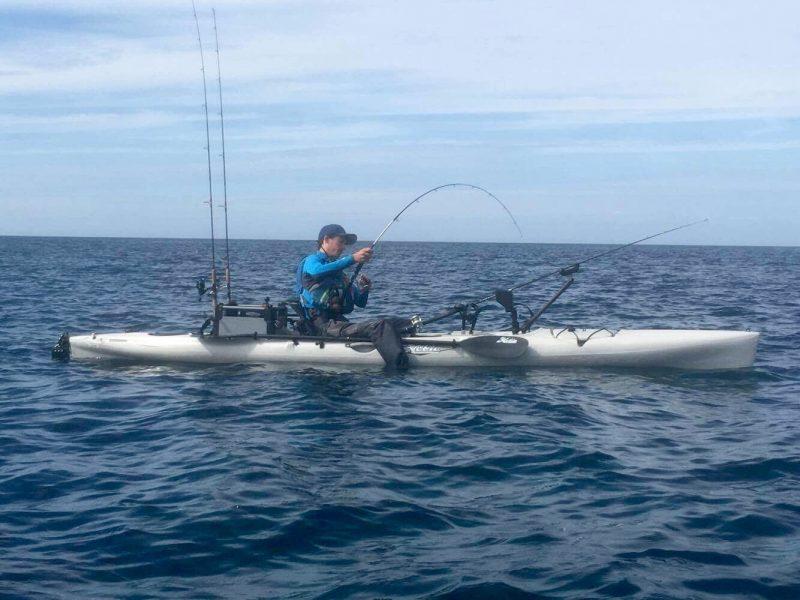
A ray will put a good bend in your rod!
Landing a ray on a kayak
Now that you have successfully hooked a ray and brought it to the kayak, the next step is to bring the fish on-board for un-hooking before either release or dispatch if you wish to eat it. Most ray species are covered in numerous very sharp spines so care must be taken when handling. For the welfare of your hands and the fish DO NOT pick up a ray by its tail. A ray is best lifted from the water and handled by grabbing the area either side of its nose. Here you will find a ridge of cartilage running along the edge of the fish and it makes a convenient handle to grab! Lifting a ray this way is the safest way for both the angler and the fish, and is recognised by the Shark Trust as the correct method of handling a ray.
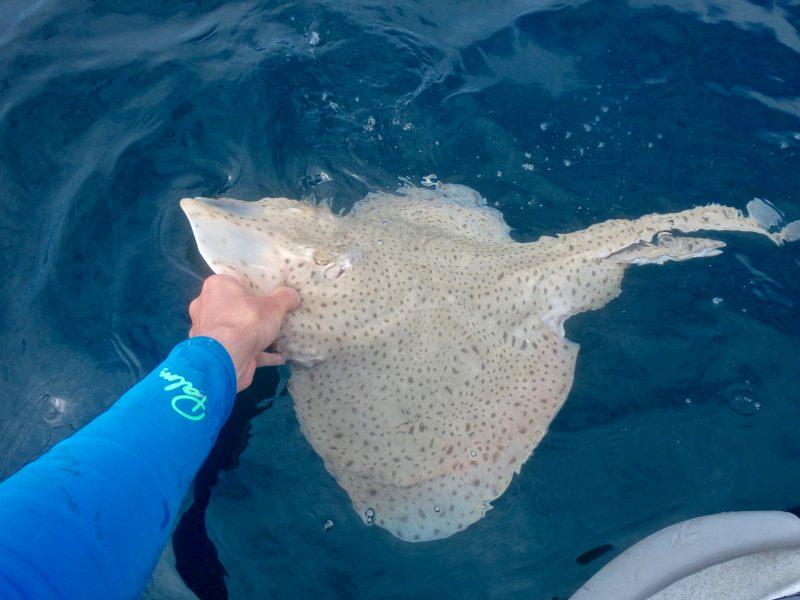
Rays can be securely held by grabbing the ridge of cartilage at the side of their head
Lift the fish onto your lap and turn over to reveal the mouth. BEWARE of the mouth – the powerful lips are covered in bony lumps that will easily crush fingers and rip skin should they bite you! Forceps are often handy for unhooking ray.
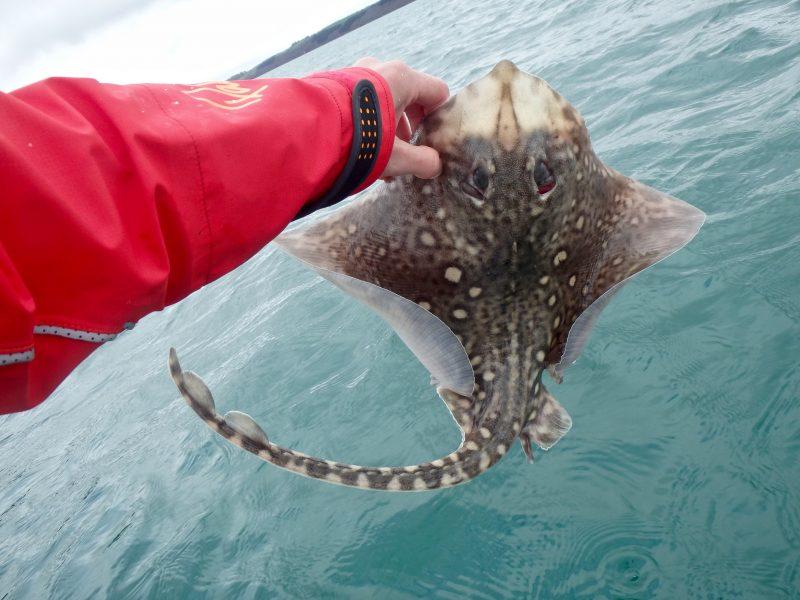
Once you have a firm grip on the ray you can lift it into the kayak
Rays offer some really great sport for the kayak fisherman, so get down to your local ray mark and find some rod-bending action!
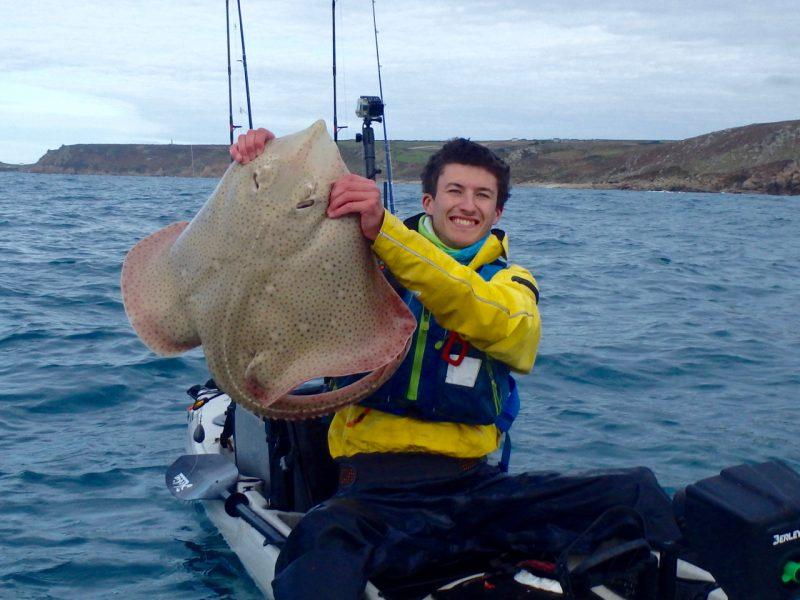
A 20 lb Blonde Ray caught Kayak Fishing
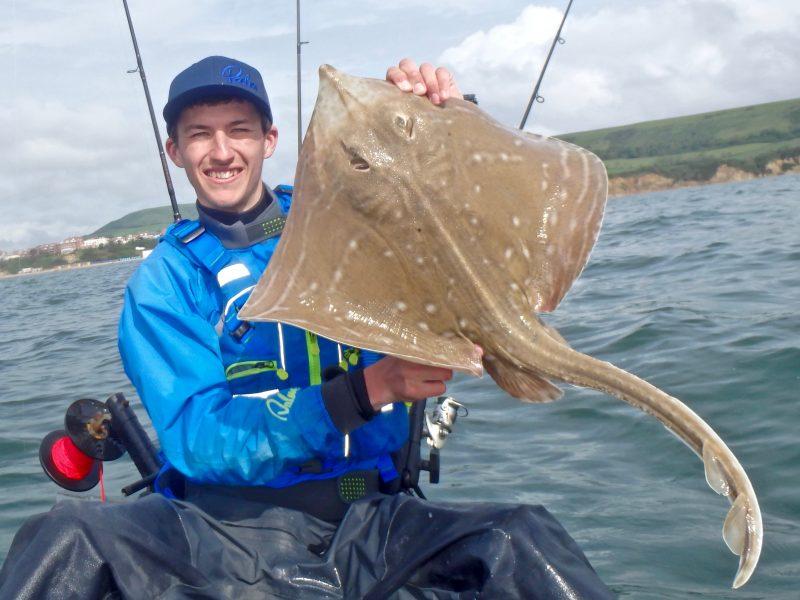
A 10 lb Small Eyed Ray caught from the kayak

An 11 lb Undulate Ray caught kayak fishing